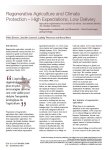Zimmer Y., Lammel J., Theuvsen L., Ward B. (2025). Regenerative agriculture and climate protection - High expectations, low delivery. Eurochoices, 01/04/2025, vol. 24, n. 1, p. 20-26.
https://doi.org/10.1111/1746-692X.12464
https://doi.org/10.1111/1746-692X.12464
| Titre : | Regenerative agriculture and climate protection - High expectations, low delivery (2025) |
| Auteurs : | Y. Zimmer ; J. Lammel ; L. Theuvsen ; B. Ward |
| Type de document : | Article |
| Dans : | Eurochoices (vol. 24, n. 1, April 2025) |
| Article en page(s) : | p. 20-26 |
| Langues : | Anglais |
| Langues du résumé : | Anglais ; Français ; Allemand |
| Catégories : |
Catégories principales 06 - AGRICULTURE. FORÊTS. PÊCHES ; 6.4 - Production Agricole. Système de ProductionThésaurus IAMM SYSTEME DE PRODUCTION ; AGRICULTURE ; REGENERATION ; PROTECTION DE L'ENVIRONNEMENT ; IMPACT SUR L'ENVIRONNEMENT |
| Mots-clés: | AGRICULTURE REGENERATRICE |
| Résumé : | Regenerative agriculture has gained attention for its potential to mitigate greenhouse gas (GHG) emissions from crop production and improve farm profitability through practices like cover cropping and reduced tillage. However, empirical data suggest that the carbon storage potential and economic benefits of these methods are often overstated. Research shows that the capacity of these practices to sequester carbon is limited. Furthermore, under challenging climatic conditions, these techniques can even reduce crop yields. The paper demonstrates that economic benefits are often based on assumptions that do not account for challenges, such as the limited feasibility of cover crops in certain cropping systems and exaggerated savings from reduced inputs. Moreover, the potential for ?leakage? ? where lower yields lead to land conversion and emissions elsewhere ? raises further concerns about the effectiveness of the concept. A more promising approach lies in improving nitrogen-use efficiency, which addresses the major source of GHG emissions from crop production while reducing input costs and improving productivity. Unlike regenerative practices that often depend on subsidies, improving nitrogen use efficiency offers stable, measurable results without yield penalties or the need for continuous financial compensation of growers. This ensures long-term sustainability and climate benefits, making it a more promising strategy. |
| Cote : | En ligne |
| URL / DOI : | https://doi.org/10.1111/1746-692X.12464 |







